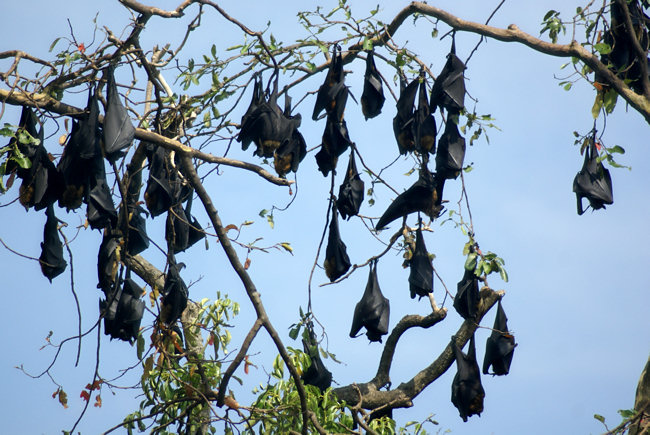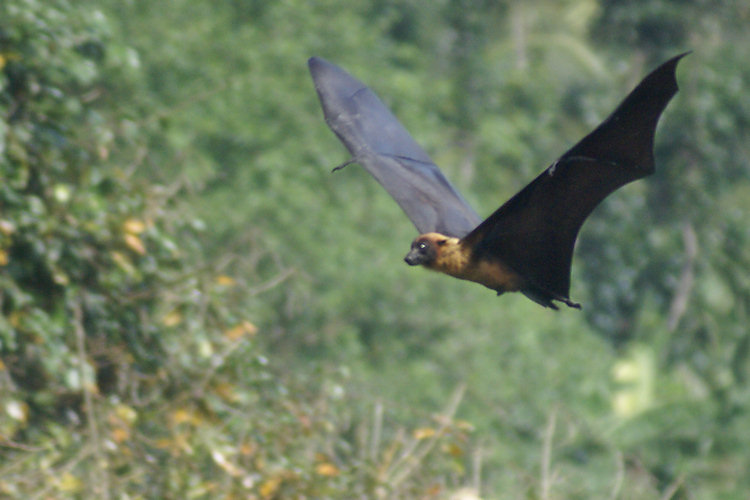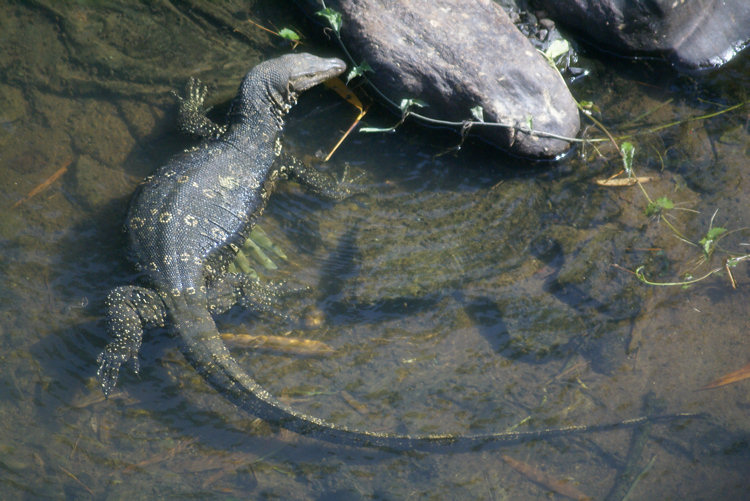Journey to Pinnewala Elephant Orphanage in Sri Lanka
On your journey to the Pinnewala Elephant Orphanage from Kandy ask your driver to stop on the white painted Mahaly Gunga river Bridge. Many don't as they are in a rush to get you to the Elephant Orphanage. Gunga means river in Singhalese.

flying fruit bats
You know you are at the right place as there are two restored old steam rollers exhibited on the side of the road by the bridge. What is so important about this bridge you might ask. Bats is the answer. Look up in the trees either side of the bridge. You will see hundreds of roosting large fruit bats. If you are lucky you might see some flying above the tree tops or under the bridge down the lush tropical valley.
Tips on taking Photos of flying fruit bats
Attach your telephoto lens to your camera and put your mode setting to sports. Focus on a distant object and then turn your auto focus off by setting it to manual, otherwise you will miss taking some fantastic shots because your camera will be constantly trying to focus on these large fast moving furry flying rodents.

Tips on taking Photos of flying fruit bats
Asian Water Monitor Lizard
If you are very lucky you may even be able to see the rare Asian Water Monitor Lizard swimming near the bridge. Apparently they like the shade caused by the bridge in hot midday sun. It is a favourite location. Monitor Lizards are cold blooded. In the morning and late afternoon you may see them basking on a rock or up a tree.
Water Monitor Lizard are a cousin of the more common Land Monitor Lizard. It is strange to see a large Water Monitor Lizard swimming near women washing their cloths. You instantly want to shout to them a warning but it is not necessary. Water Monitor Lizard's have no interest in humans. They are not on a Water Monitor Lizard's food menu. Don't go to near one. Although they don't eat live humans they can cause you injuries if they feel trapped. They use their jaws, claws and strong tail in defence. Normally they will run or swim away rather than confront a person.
The Asian Water Monitor Lizards in Sri Lanka can grow up to 10 feet (3m) but most only reach around 5 feet long (1.5m). There is not much of a size difference between the sexes. The locals call them Kabaragoya and in Tamil they are called Udumbu. Monitor Lizards eat meat. They kill frogs, crabs, rats, mice, voles, ducklings, snakes, turtles, locusts, fish, domestic chickens, small crocodiles and devour crocodile eggs if Mummy Crocodile has gone for a swim. They also eat carrion. If a cow has drowned in the river they will pull it apart. Unlike their bigger cousin the Komodo Dragon their bite is not venomous.

Asian Water Monitor Lizard
Try to catch a glimpse of their forked tongue which they stick out to find new food. They use it to smell for their prey. I know this sounds strange. They have strong legs and can run faster than humans. They like to chase their prey rather than wait in ambush. Although they are called Water Monitor Lizards they can also climb trees by using their claws. They climb trees to escape from predators and find insects or cool shade.
Children love spotting them. They look like modern day dinosaurs. Young juvenile Asian Water Monitor Lizards tend to have yellow speckling which dulls down as they get older. They reach maturity at two years. They normally have a life span of 15 years. They lay about 15-20 eggs per batch. A female Lizard can lay 40 eggs a year in two batches.
They use burrows near the river to hide in. Their long powerful tail makes them strong and agile swimmers. They can also hold their breath under-water for a long time. In captivity a Water Monitor Lizard remained under water for thirty minutes.
Porcupines
Don't stop to take photographs of the street traders with Asian Porcupines on leads. You will just encourage this despicable trade in wild animals. They are captured in the Jungle and paraded for the tourist trade. It is no life for these beautiful animals. They are condemned to spend all their daylight hours for the rest of their days on a dusty roadside on a dogs lead.
Elephant Rides
On the road up to Pinnewala Elephant Orphanage you will see ramshackle establishments offering elephant rides to tourists. These elephant's living conditions in contrast to those at the Orphanage are pitiful. Do not support them. They are not allowed to walk freely or play when they want to. They are not in large family groups. They do not have access to the river. They are controlled by men with sharp pointed sticks and chained up for most of the time. Spend your tourist 'dollar' at an establishment that has the elephant's welfare as its primary concern.
Travel books

